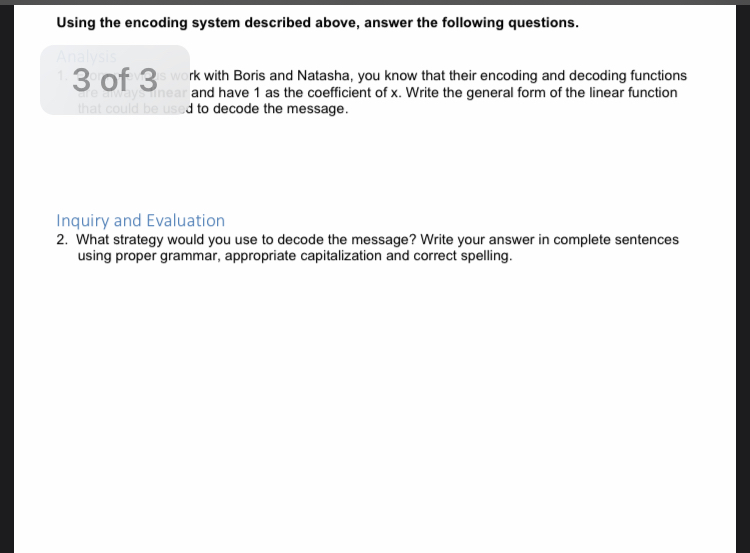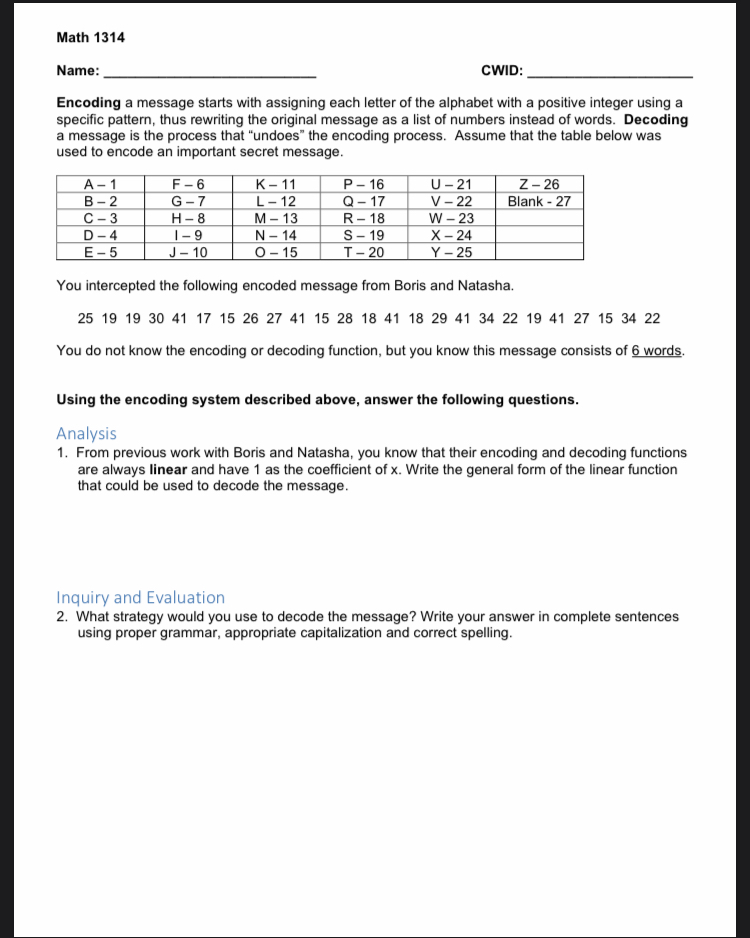Homework help.
algebra 1314
source pictures attached below with the explanation question as well.
Evaluation 3. Write the decoding function. Use proper function notation. Synthesis 4. What is the decoded message? 5. Why is it necessary for the encoding function to be one-to-one? Give a clear, thorough, explanation specific to this assignment. Use complete sentences, correct spelling, appropriate capitalization, and proper grammar.Using the encoding system described above, answer the following questions. 3 Of 3 work with Boris and Natasha, you know that their encoding and decoding functions "near and have 1 as the coefficient of x. Write the general form of the linear function that could be used to decode the message. Inquiry and Evaluation 2. What strategy would you use to decode the message? Write your answer in complete sentences using proper grammar, appropriate capitalization and correct spelling.Math 1314 Inverse Functions Cryptology is the science of making and breaking codes. This activity explores how the idea of functions and their inverses can be used to encode and decode messages. To encode a message, first replace each letter of the alphabet with a positive integer using the following scheme, thus rewriting the original message as numbers instead of words. A- 1 F - 6 K - 11 P - 16 U-21 Z -26 B- 2 G- 7 L - 12 Q - 17 V - 22 Blank - 27 C- 3 H-8 M - 13 R - 18 W - 23 D - 4 1-9 N - 14 S - 19 X - 24 E -5 J - 10 0 - 15 T - 20 Y - 25 ENCODING: A one-to-one function can be used to encode a numerical message. For example, suppose you want to send the message MATH to a friend, and you have decided that the function f(x) = 3x + 4 will be the encoding function. This function simply describes the procedure used to create the encoded message - in this case multiply by 3 and add 4. First change the letters to corresponding numbers as shown above: 13 1 20 8. Then use these as the input values in f(x). f(13) = 3(13) + 4 = 43 f(1) = 7 f(20) = 64 f(8) = 28 So the encoded message that you send to your friend is: 43 7 64 28 NOTE: A graphing calculator can be used to evaluate a function as above: a. Press [Y=]_on the calculator. Type 3x + 4. b. Choose [2nd][WINDOW] (TBLSET). Set the independent variable to Indont: Ask. c. Then choose [2" ][GRAPH] (TABLE). Input each x value (13 1 20 8). The calculator will return the function values (43 7 64 28) which is the encoded message. DECODING an encoded message: Now it is up to your friend to decode the message. Decoding is the process that "undoes" the encoding process. If f(x) encodes the message, what will decode it? The inverse of f(x) or f1(x)! So f1(x) will be the decoding function. In the example, the inverse of f(x) = 3x + 4 can be shown to be fi(x) = . Take the encoded 3 message (43 7 64 28) and use these values as input values in f-(x). Again, the calculator can be used to decode - simply enter y = * = 4 3 and use the TABLE feature as described above. f-1(43) = 13 f-1(7) = 1 f-1(64) = 20 f-1(28) = 8 That's the original numerical message! The last step is to convert back to letters using the table given previously. Now your friend knows the message that you sent: MATH.Math 1314 Name: CWID: Encoding a message starts with assigning each letter of the alphabet with a positive integer using a specific pattern, thus rewriting the original message as a list of numbers instead of words. Decoding a message is the process that "undoes" the encoding process. Assume that the table below was used to encode an important secret message A- 1 F - 6 K - 11 P - 16 U - 21 Z -26 B - 2 G -7 L - 12 Q - 17 V - 22 Blank - 27 C - 3 H - 8 M - 13 R - 18 W - 23 D- 4 1-9 N - 14 S - 19 X - 24 E-5 J - 10 O - 15 T - 20 Y - 25 You intercepted the following encoded message from Boris and Natasha. 25 19 19 30 41 17 15 26 27 41 15 28 18 41 18 29 41 34 22 19 41 27 15 34 22 You do not know the encoding or decoding function, but you know this message consists of 6 words. Using the encoding system described above, answer the following questions. Analysis 1. From previous work with Boris and Natasha, you know that their encoding and decoding functions are always linear and have 1 as the coefficient of x. Write the general form of the linear function that could be used to decode the message. Inquiry and Evaluation 2. What strategy would you use to decode the message? Write your answer in complete sentences using proper grammar, appropriate capitalization and correct spelling










